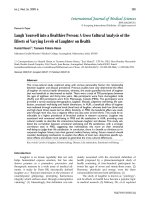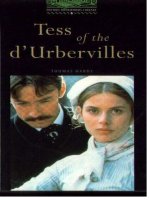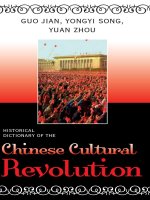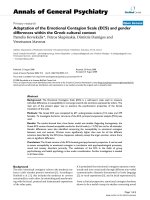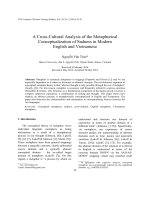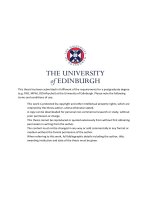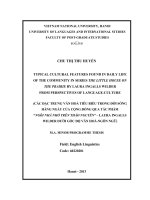Cultural Criticisms Within Thomas Hardys Tess of the DUrbervill
Bạn đang xem bản rút gọn của tài liệu. Xem và tải ngay bản đầy đủ của tài liệu tại đây (461.97 KB, 47 trang )
Cleveland State University
EngagedScholarship@CSU
ETD Archive
2016
Cultural Criticisms Within Thomas Hardy's Tess of the
D'Urbervilles
Holly Rose Litwin
Cleveland State University
Follow this and additional works at: />Part of the English Language and Literature Commons
How does access to this work benefit you? Let us know!
Recommended Citation
Litwin, Holly Rose, "Cultural Criticisms Within Thomas Hardy's Tess of the D'Urbervilles" (2016). ETD
Archive. 870.
/>
This Thesis is brought to you for free and open access by EngagedScholarship@CSU. It has been accepted for
inclusion in ETD Archive by an authorized administrator of EngagedScholarship@CSU. For more information,
please contact
CULTURAL CRITICISMS WITHIN THOMAS HARDY’S
TESS OF THE D’URBERVILLES
HOLLY R. LITWIN
Bachelor of Arts in English and American Literature
Brandeis University
May 1991
Submitted in Partial Fulfillment of Requirements for the Degree
MASTER OF ARTS IN ENGLISH
at the
CLEVELAND STATE UNIVERSITY
May 2016
We hereby approve this thesis for
Holly R. Litwin
Candidate for the Master of Arts in English degree for the
Department of English
and the CLEVELAND STATE UNIVERSITY
College of Graduate Studies
_________________________________________________________________
Thesis Chairperson, Dr. Rachel Carnell
_____________________________________________
Department & Date
_________________________________________________________________
Thesis Committee Member, Dr. Gary R. Dyer
_____________________________________________
Department & Date
_________________________________________________________________
Thesis Committee Member, Dr. James Marino
_____________________________________________
Department & Date
Student’s Date of Defense: April 7, 2016
CULTURAL CRITICISMS WITHIN THOMAS HARDY’S
TESS OF THE D’URBERVILLES
HOLLY R. LITWIN
ABSTRACT
To understand fully Thomas Hardy’s cultural criticisms within his 1891 novel
Tess of the d’Urbervilles, one must look simultaneously at the full range of these cultural
criticisms. The novel is a scathing condemnation of capitalism, Victorian beliefs about
women, church doctrine, the shortcomings of the educational and judicial systems, and
the destructive forces that industrialization and mechanization bring to the natural world
in rural agrarian England. Within the past twenty years, scholars have explicated this text
in ever-more specific, detailed, and narrow areas of focus, often coming up with
fascinating and meticulously researched individual topics. However, I believe that a
much broader and more expansive literary explication of Tess is required in order to
understand the vast array of cultural criticisms contained within the novel. To
comprehend the multifaceted and complex alienated condition of modernity that Tess
depicts and deplores, a more expansive reading of the novel is necessary.
iii
TABLE OF CONTENTS
ABSTRACT ....................................................................................................................... iii
CHAPTER I INTRODUCTION ........................................................................................ 1
CHAPTER II ECONOMIC AND GENDER INEQUALITY ........................................... 7
CHAPTER III CRITIQUING VICTORIAN INSTITUTIONS AND VALUES ............ 21
CHAPTER IV THE COMPLEXITY AND POWER CONTAINED WITHIN TESS OF
THE D’UBERVILLES ..................................................................................................... 39
BIBLIOGRAPHY ............................................................................................................. 41
iv
CHAPTER I
INTRODUCTION
Thomas Hardy’s Tess of the d’Urbervilles (1891) contains complex and detailed
interrogations of many Victorian values and of the capitalist culture of his time. This
novel is a fierce condemnation of the social, ethical, moral, religious, and political values
held by the majority of Hardy’s cultural elite contemporaries in England. The most
obvious example of Hardy’s cultural criticism is his assertion in the novel’s subtitle that
Tess is “A Pure Woman.” By traditional Victorian standards, Tess is a fallen woman and
as such is considered damaged goods suitable for the lowest bidder. Hardy is radically
departing from these values by proclaiming Tess’s purity and virtue even though she has
had sexual relations outside of marriage. It is, therefore, not surprising that initial reaction
to the novel was highly negative. “[A]s everyone knows, this novel stirred up a furious
controversy” Keith (83). As a result of the hostility the novel met because of its attack on
widely held societal beliefs about chastity and feminine purity, Hardy vowed to give up
novel writing. “Well if this sort of thing continues,” Hardy proclaimed, “no more novelwriting for me. A man must be a fool to deliberately stand up to be shot at” (Zietlow 6).
1
Hardy considered Tess to be one of his greatest literary accomplishments, which is why
in his general preface to the 1912 Wessex edition of Tess he placed the novel among his
“Novels of Character and Environment.” While early critics were scornful of the novel’s
questionable morality, it was well received by the reading public.
Early twentieth-century critics of Tess were correct in noting that Hardy is
arguing against the double standard that allows men to have sexual relations outside of
marriage but condemns women for doing so no matter what the circumstances. Tess did
not consent to a sexual relationship. She was raped by Alec, yet she was condemned by
society for having a child out of wedlock as a result of the rape. This cultural criticism is
one of Hardy’s many challenges to the social conventions and values of his time found
within this text. Tess’s struggle with Alec is both a gender and a class conflict. The text
uses Tess’s relationship with Alec to expose the similarities and interconnections
between a man’s physical and emotional oppression of a woman, on the one hand, and a
more powerful social class’s economic oppression and destruction of a weaker class, on
the other. Hardy’s Tess laments the destruction of the independent rural artisan class and
blames nouveaux riche capitalist society for this degradation. Hardy goes on to condemn
the industrialization of agricultural work because of what he views as the extremely
destructive impact of technology and mechanization upon the quality of the rural
workers’ lives. Hardy is also extremely critical of organized Christianity in several places
throughout the novel, including the scene in which Sorrow is actually denied a Christian
burial. Hardy also raises questions about the injustice and inequality of a legal system,
which finds Alec innocent of any wrongdoing but sentences Tess to death.
2
Studying the history of the literary and critical reception of Tess reveals the
breadth and depth of Hardy’s cultural criticisms. In 1998 John Paul Riquelme published
a detailed study of the past one hundred years of literary analysis and critical history of
this novel. He writes that for all those years, “Tess has been a significant stimulus to
thinking about cultural values, both moral and aesthetic” (389). Riquelme gathers a vast
amount of Marxist, materialist, and feminist literary analysis of Tess from the 1950s
through to the 1990s. He describes how “intense energy has gone into feminist
interpretations of Hardy, including centrally Tess. It is unlikely that any other male
author writing in English has attracted more attention from feminist critics, a great deal of
it thoughtful and positive” (400).
Peter Widdowson’s “Hardy and Critical Theory” published in the 1999
Cambridge Companion to Thomas Hardy also explores in detail the evolution of critical
approaches to the analysis of Thomas Hardy’s literature and poetry over the past century.
Widdowson writes that Hardy was:
a widely read intellectual closely familiar with the literary debates of
the second half of the nineteenth century. For the purposes of the
present essay, we may deduce one – albeit crucial – feature of
Hardy’s involvement in these: one which casts him as ineluctably
“transitional” between “Victorian” and “Modern” and which
suggests the affinity between his work and late-twentieth-century
critical approaches. If we read between the lines of the three fiction
essays – verified by jottings in his notebooks and by memoranda
quoted in The Life and Work of Thomas Hardy – it is apparent that
Hardy is actually participating in the pan-European debate about
Realism, and that he was opposed to a “photographic” naturalism,
favoring instead a kind of “analytic” writing which “makes strange”
common-sense reality and brings into view other realities obscured
precisely by the naturalized version (74).
3
He describes how Hardy was opposed to the idea that literature should be a photographic,
naturalistic representation of human experiences. Widdowson draws attention to Hardy’s
own assertion in The Life and Work of Thomas Hardy that:
Art is disproportioning – (i.e., distorting, throwing out of proportion) – of
realities, to show more clearly the features that matter in those realities,
which, if merely copied or reported inventorially, might possibly be
observed, but would more probably be overlooked. Hence ‘realism’ is not
Art (74).
Widdowson describes how Hardy’s fiction, including Tess, has been analyzed by
“socialist-feminist, materialist-poststructuralist, or feminist-poststructuralist approaches”
(80). Widdowson explains, “What they all have in common, however, is a cultural
politics which seeks to subvert the orthodox “Hardy” and to (re)mobilize the
“disproportioning” dimension of his work” (80).
By the mid 1990s, feminist literary critics wrote extensively about gender issues
and the status of women within Tess while Marxist literary critics explored the role that
class conflict plays within the novel. Penny Boumelha’s groundbreaking book, Thomas
Hardy and Women Sexual Ideology and Narrative Form, which was published in 1982,
devotes an entire chapter to Tess. This chapter simultaneously examines the novel from
both a Marxist and a feminist perspective. Boumelha writes about “the components of
Tess’s complex class-position (decayed aristocratic lineage, economic membership of the
newly-forming rural proletariat, modified by an education that provides her with a degree
of access to the culture of the bourgeoisie” (117).
She emphasizes that within Tess,
Hardy is depicting “the fact that sexual and marital relationships are presented in such
direct relation to economic pressures and to work” (119).
4
Since the start of the twenty-first century, literary critics writing about Tess have
focused in ever-greater detail on very specific aspects of the novel. Zena Meadowsong’s
2009 “Thomas Hardy and the Machine: The Mechanical Deformation of Narrative
Realism in Tess of the d’Urbervilles” is an excellent example of this specificity.
Meadowsong focuses extensively on mechanization within the novel and how the scenes
describing machines themselves have a mechanical syntax. She states:
I wish to argue that the ‘defects’ of the novel are in a literal sense the work
of mechanization. The machine enters Tess of the d’Urbervilles not only
as the diabolical agent of modernization but – driving the action of the
novel and producing its effects – as the primary determinant of novelistic
form (231).
Deanna K. Kreisel’s 2012 book Economic Woman devotes ten pages of her chapter on
Tess to a highly detailed analysis of late Victorian milk production, distribution, safety
and health concerns as well as late Victorian attitudes towards nursing mothers. This
fascinating and meticulously researched social history about the role of milk in late
Victorian society in the chapter Self-Sacrifice, Skillentons, and Mother’s Milk seems a bit
removed from the novel itself and only distantly connected to the scenes at Talbothay’s
Dairy described within Tess.
I wish to argue that only by simultaneously considering all of Hardy’s social
commentary and value judgments within the novel can one fully understand the complex
and detailed cultural criticisms that Hardy raises about the bourgeois capitalist Victorian
society in which he lived. Hardy constructed the novel so that in telling Tess’s life story,
the legitimacy of the Church, the legal system, capitalism, mechanization and the status
of women were challenged. When explored as a whole, the novel’s cultural criticisms
harshly condemn the status quo of nearly every major societal institution. Rather than
5
focusing on an individual element, I believe that a broad and expansive literary
explication of Tess is required in order to comprehend the depth and breadth of cultural
criticisms contained within the novel.
I am in agreement with modern scholar and literary critic Linda Shires who writes
in “The Radical Aesthetic of Tess of the d’Urbervilles”:
Texts in this tradition were expected to participate in ideological critique
and transform the consciousness of readers. I would claim such effects for
Hardy’s text, just as I would claim the general intellectual influence of this
tradition on him, whether indirect or direct. Texts in this tradition both
reproduce the myths through which the nineteenth century operated and
imagined itself (how it sees the past, how it views fallen women, how it
defines love, how it rationalizes industrialism) and critique them at the
same time. This is, I believe, the substance of Hardy’s literary project not
only in Tess but in all his novels, to greater or lesser degrees. (161)
The richness of the text lies in the fact that Hardy was able to critique a broad range of
cultural and ideological conventions within Tess without the novel losing its passionate
recounting of Tess’s life or slipping into an overtly didactic tone. Most importantly, the
key to unlocking this vast amount of social criticism and ideological convention is to shift
away from the recent tendency of micro focus back to more of a macro focus when
analyzing the complex and interconnected cultural criticisms within Thomas Hardy’s
Tess of the d’Urbervilles.
6
CHAPTER II
ECONOMIC AND GENDER INEQUALITY
It is best to begin the simultaneous exploration of Thomas Hardy’s cultural
criticisms within Tess by focusing on the economic and gender inequality found within
the novel. This complex subject matter is vital to the novel’s plot. Tess’s struggle with
Alec plays a central role in the novel and this struggle is both a gender and a class
conflict. Early twentieth-century critics originally focused in isolation on either the class
or gender elements of the conflict. Either a Marxist or a feminist critique of the novel
was used in isolation to explicate the text. However, later critics realized the importance
of simultaneously examining the novel from both a Marxist and a feminist perspective.
Hardy depicts Tess’s struggle with Alec as both a gender and class conflict. The text
uses Tess’s relationship with Alec to expose the similarities and interconnections
between a man’s physical and emotional oppression of a woman, on the one hand, and a
more powerful social class’s economic oppression and destruction of weaker class, on the
other.
In 1954, Marxist critic Arnold Kettle argued that although “the subject of Tess of
the d’Urbervilles is stated clearly by Hardy to be the fate of a ‘pure woman’; in fact it is
the destruction of the English peasantry” (49). Likewise in 1990, Marxist critics have
7
upheld the validity and importance of a Marxist interpretation of the novel. John Goode
writes, “I think it can be argued that . . . Tess of the d’Urbervilles permits and demands a
Marxist reading” (33). However, the nature of the Marxist criticism has changed,
becoming less reductive. No longer are the subject of Tess’s purity and the status of
women considered in opposition to the subject of the destruction of the peasantry and
class conflict. Goode argues, “The two sources of power in the novel are gender and
class. Tess is finally made into a woman by violation and into a field woman by
economic oppression” (33). Goode correctly acknowledges that Alec’s rape of Tess is the
physical violation of a woman by a man, which Hardy uses to symbolize the destruction
of the independent rural artisan class by the nouveaux riche.
Alec’s exploitation of Tess and all of the misery she suffers in her short life
remain an emotionally charged personal tragedy. Many passages throughout the text urge
readers to see the exploitation of Tess and its aftermath as symbolic of the overall
injustice and inequality of Victorian England’s status quo. In order to achieve this goal,
Hardy clearly establishes both Alec and Tess’s socioeconomic backgrounds. Tess’s father
is a “haggler” (43) of eggs, dairy produce, and beehives. The Durbeyfield family’s
“rickety little wagon” (68) and their “horse Prince, only a degree less rickety than the
vehicle,” (68) are crucial to their economic survival. Because Tess feels responsible for
the collision, which results in Prince’s death, she reluctantly agrees to visit and attempts
to claim kin with the wealthy d’Urberville family. However, after initially visiting the
d’Urberville estate, Tess is horrified. She does not acquiesce in Alec’s desire that she be
employed on his family’s estate but instead looks for agricultural employment within her
8
own village. Only after Tess is unable to find work elsewhere does financial necessity
drive her to accept Alec’s offer of employment.
Hardy clearly defines Tess as a member of the independent rural artisan class, a
group whose way of life as a whole he asserts is at risk of extinction and whose quality of
life is in decline due to capitalist economic forces and the industrialization of agricultural
labor. He writes:
The village had formerly contained, side by side with the agricultural
labourers, an interesting and better-informed class, ranking distinctly
above the former - the class to which Tess’s father and mother had
belonged - and including the carpenter, the smith, the shoemaker, the
huckster, together with nondescript workers other than farm-labourers; a
set of people who owed a certain stability of aim and conduct to the fact of
their being life-holders like Tess’s father, or copyholders, or, occasionally,
small free-holders. But as the long holdings fell in they were seldom again
let to similar tenants, and were mostly pulled down. (435)
Hardy’s description of Alec’s family embodies all that Hardy maintains is wrong
with capitalist nouveaux riche society: there, money and status are more valuable and
significant than people. Hardy’s depiction of the d’Urberville estate and of Alec’s
behavior during Tess’s initial visit leaves no doubt that money is most important to the
d’Urbervilles. The d’Urberville estate, The Slopes, was “a country-house built for
enjoyment pure and simple, with not an acre of troublesome land attached to it beyond
what was required for residential purposes” (77). The d’Urbervilles view land as
troublesome and therefore choose not to farm. Their estate is right next to “one of the few
remaining woodlands in England of undoubted primaeval date” (77) and in complete
contrast to it. The brand new mansion house and crimson brick lodge glaringly contrast
with the ancient forest next to which they were constructed. The d’Urbervilles use money
and technology to dominate nature. Their estate contains conservatories and greenhouses,
9
which alter the seasons in which produce can be grown. It is not surprising that Alec later
repeatedly tries to use money and power to get Tess to comply with his own will.
The most striking and significant aspect of the d’Urberville estate is that
everything “looked like money - like the last coin issued from the mint” (77). Alec’s
father, Mr. Stoke, is a capitalist who uses his wealth to purchase a new identity for his
family. After having made his fortune as a merchant in the North of England, he settled
his family in the South, as far away from his business district as possible, and altered the
family name. By paying for the title of d’Urberville, once an upper class family in
Wessex but now extinct, Mr. Stoke literally buys social status. Hardy disapproves of Mr.
Stoke’s attempt to purchase a new, more prestigious identity for his family. Throughout
the text Alec is called a “sham d’Urberville” (437). The narrator refers to Alec’s family
as “spurious [and] compounded of money” (183). As Ian Gregor has observed, “Alec’s
world, the world of the Stoke-D’Urbervilles, is inseparable from nineteenth-century
laissez-faire capitalism, it is the triumph of the individual bourgeois ethic, what is wanted
can be bought” (192).
Alec’s mother, who is no better than his father, maintains a small fowl farm as a
hobby. She dotes excessively upon her birds, yet shows utter disrespect for humanity and
especially for village families below her own status. Hardy depicts Mrs. Stoked’Urberville as follows:
The descendants of these bygone owners felt it almost as a slight to their
family when the house which had so much of their affection, had cost so
much of their forefathers’ money, had been in their possession for several
generations before the d’Urbervilles came and built here, was indifferently
turned into a fowlhouse by Mrs. Stoke-d’Urberville as soon as the
property fell into hand according to law. (99)
10
Merryn Williams notes that this passage “is an early reference to the squeezing out of the
intermediate class” (120) in rural England at the turn of the century. Throughout the
novel, Hardy’s narrator documents and laments the increasing prevalence of this
squeezing out of the independent rural artisan class long before the reader learns that
Tess’s family suffer the same fate.
Alec’s parents value possessions more than they respect human beings. They have
taught Alec that money buys status and that might makes right. The d’Urbervilles’
obsession with money, power, and status has perverted their priorities. They have
destroyed their own humanity by defining themselves by their wealth and using it to
literally reinvent their family’s identity. Hardy’s description of the d’Urbervilles is a
scathing condemnation of capitalist culture because it shows the validity of Karl Marx’s
belief that “[w]ith the increasing value of the world of things proceeds in direct
proportion the devaluation of the world of men” (71).
The facets of Alec’s relationship with Tess illustrate the destructive and harmful
ramifications of class oppression and male domination of women. Because Alec is
obsessed with Tess physically, he refuses to take her will into account and uses his
financial status to take advantage of her. He thinks that his superior social standing
entitles him to whatever he wants, including a sexual relationship with her. For Alec,
Tess is no longer a person whose desires need to be respected but an inferior whose
companionship and sexuality can be bought.
As he transports her from Marlott to his estate, Alec repeatedly demands that Tess
kiss and touch him, even though he knows that she abhors doing so. She protests and
11
declares, “Never!” After each kiss that he forces upon her, Alec declares, “I’ll stop - on
my honour I will!” (96). However, immediately afterwards he breaks his promise and
again tries to kiss her. During his second attempt, Tess “dodge[s] aside” (96) in order to
protect herself. Instead of deterring Alec, her resistance only infuriates Alec and makes
him more determined than ever to have his way with her. He threatens her, “You shall be
made sorry . . . unless you agree willingly to let me do it again” (97). In other words,
Alec is fully aware that up until this point Tess has not willingly allowed him to have
sexual contact with her. Even his initial kiss is described as “the kiss of mastery” (96).
This clearly shows that Alec is trying to dominate Tess and force his desires upon her. He
lusts after her and sees no reason why her feelings and wishes should be taken into
account since they are the opposite of his. He believes that her will should be subservient
to his and that he should be the one who controls what happens to her physically.
Because Tess fights back by refusing his advances and insisting upon walking alone the
rest of the way to the estate, Alec “cursed and swore at her” (98). Tess vehemently cries
out to Alec, “I hate and detest you!” (98), yet even this does not stop Alec. He responds,
“Well I like you all the better” (98). Nothing Tess does or says can diminish Alec’s desire
for sexual contact because he views her as a sexual object to be conquered and not as an
equal whose requests need to be respected.
Alec’s sexual harassment and exploitation of Tess culminates in the rape. One of
the reasons Alec is capable of raping Tess is that he views her as a mere “cottage girl”
who is overly “sensitive” (97). Alec is convinced that his gender and his superior wealth
and social standing give him the right to have his way with her. In fact, he informs Tess
that he has bought her father a new horse just hours before he rapes her. The gift of the
12
horse to the family is not charity but Alec’s way of using his financial hold over Tess to
enslave her. Tess understands this and so although she desperately wants to replace her
father’s horse, when Alec tells her he has done so, she responds, “I almost wish you had
not” (117). Alec is convinced that because Tess is a mere rural girl, her will does not
count and he can do what he likes to her. Their disparate economic and social status gives
Alec the power to do so.
The rape itself is described as “the coarse appropriat[ing] the finer” (119). The
economic term of appropriation is used to describe the disfiguring of natural relations
among people. Alec has appropriated Tess’s virginity. As Rosemarie Morgan points out,
the rape is
an act of theft, a dishonest appropriation of another’s property with the
intent to deprive her of it permanently. The term suffices to denote the
moral nature of the act, which passes beyond sexual assault to take
account of violation of rightful ownership. It is a fitting emphasis in a
novel that stresses a sexual ethic that denies woman the right to control not
only her own mode of existence but also her own body. (94)
Likewise, Mary Jacobus describes the rape as a scene in which “sexual and economic
oppression are closely identified” (83). Hardy’s narrator makes it clear that Alec’s raping
of Tess is meant to be understood within the overall historical context of the continued
domination and victimization of women by men in positions of superior power, including
Tess’s forebears. In describing the rape Hardy writes, “Doubtless some of Tess
d’Urberville’s mailed ancestors rollicking home from a fray had dealt the same measure
even more ruthlessly towards peasant girls of their time” (119).
Within Tess, Hardy criticizes Victorian England’s moral standards for continuing
to validate and legitimize this specific type of abuse and all other forms of male
13
domination and gender inequality. He has his heroine defy the prevailing societal views
about the value of women and female purity by asking, “Was once lost always lost really
true of chastity? . . . She might prove it false” (150). Tess’s relationship with her husband
Angel Clare, whom she loves deeply, is destroyed by Angel’s inability to break from the
conventional societally sanctioned ideas about women. When Angel sees Tess as “a
visionary essence of woman - a whole sex condensed into one typical form” (187), she
has to insist upon being treated as an individual and not as a female stereotype. “He
called her Artemis, Demeter and other fanciful names half teasingly . . .. Call me Tess,
she would say askance; and he did” (187). Because Angel idealizes Tess as the perfect
woman and puts her up on a pedestal to worship, Hardy explains that “Clare’s love was
doubtless ethereal to a fault, imaginative to impracticability” (315). He criticizes Angel
for falling in love with his own inflated image of what Tess represented and not with Tess
herself, Tess the actual woman.
Angel’s unwillingness to forgive Tess for not being a virgin coupled with his
belief that Tess should forgive him for having had premarital sex ruin their marriage and
cause Tess severe emotional and physical suffering. Hardy writes that Angel’s
“conventional standard of judgment” (378) causes Tess such misery. Tess ultimately
acknowledges the cruelty and hypocrisy of Angel’s value system and his treatment of her.
She writes to him:
0 why have you treated me so monstrously, Angel! I do not deserve it. I
have thought it all over carefully, and I can never, never forgive you! You
know that I did not intend to wrong you - why have you so wronged me?
You are cruel, cruel indeed! ... It is all injustice I have received at your
hands! (455)
14
The cultural criticisms of late Victorian male domination and gender inequality
found within the novel are an excellent example of Hardy’s text asking his readers to
question their values and judgments. Linda Shires describes this important phenomenon
in detail in her seminal essay “The Radical Aesthetic of Tess of the d’Urbervilles.” She
writes:
Hardy’s text asks his readers to understand the relativity of their values
and judgments. Does this mean that he is a relativist or that he is confused
about rape and consensual sex? No. It means that he sees stereotypical
values and judgments (whether against the woman: “blame the victim,”
against the man: the seducer is a cad,” or against the event: “oh dear, this
is the end of her life”) as being socially constructed, historically shaped,
and often irrelevant to a particular situation or, more subtly, irrelevant to a
discriminating readership. Self-satisfied members of Hardy’s audience,
the text repeatedly suggests, might wake up to some honest doubt and
faith, instead of relying on untested opinions and clichés. (154)
Living in South America enables Angel to understand that he was wrong to
abandon Tess and refuse to forgive her. Only after he has physically removed himself
from civilization in England by residing in the wilds of Brazil, is Angel capable of
determining for him what his real moral and ethical beliefs are. In Brazil, he finally frees
himself from mere blind acceptance of his own culture’s moral code. For the first time in
his life, Angel is truly uninhibited and capable of questioning the validity of his own
culture’s ethical doctrines and views about women. Hardy tells us that Angel “now began
to discredit the old appraisements of morality. He thought they wanted readjusting”
(421). Angel asks himself “who was the moral woman?” and concludes that “[t]he beauty
or ugliness of a character lay not only in its achievements, but in its aims and impulses;
its true history lay, not among things done, but among things willed” (421). Since Tess
obviously never wished to be raped, Angel finally realizes her innocence and purity and
is gripped with remorse over his harsh treatment of her.
15
Hardy uses Angel’s Brazilian encounter with the “large-minded stranger” (422) to
demonstrate the relativity of all religious codes and cultural value systems. In so doing,
the supreme authority and correctness of any one society’s beliefs is undermined. After
telling this stranger about what Tess had done and how he had responded to her
confession, Angel became ashamed by “[h]is own parochialism” (422), especially when
the stranger expressed his belief that Tess was innocent of any wrongdoing and that
Angel was wrong to have left her. Hardy writes:
The stranger had sojourned in many more lands and among many more
peoples than Angel; to his cosmopolitan mind such deviations from the
social norm, so immense to domesticity, were no more than are the
irregularities of vale and mountain-chain to the whole terrestrial curve.
(422)
Although Angel’s change of heart comes too late for it to be very useful to either him or
Tess, the section of the text leading up to it is of extreme importance in the overall
framework of the novel. These passages deal with the core of Hardy’s message that all
people, including Tess, should be judged not by their deeds alone but also by their will
and intentions. It also reinforces the novel’s central belief that Victorian England’s social,
ethical, religious and cultural values are imperfect. Hardy approves of Tess and Angel
ultimately questioning and criticizing parts of their own culture’s values, which are
discriminatory and oppressive, and often questions and criticizes himself through the
authorial voice of the narrator and, especially, by calling Tess a pure woman in the
subtitle.
Tess’s response to Alec after the rape and during his ongoing harassment of her is
directly contrary to what would have been considered a proper and conventional response
during that era. After Alec’s sexual assault, Tess leaves Alec and her job on the estate in
16
an attempt to break free from him both emotionally and financially. Tess believes that she
can only have physical freedom from further victimization by Alec if she is economically
independent of him and self-sufficient. Leaving is an extremely bold act on her part.
Tess’s family is shocked that Tess does not stay at The Slopes and beg Alec to marry her
or support her and her child. After the rape, Tess continues to repel Alec’s sexual
advances and offers of financial assistance.
When Alec reappears asking her to be his mistress, Tess is living in poverty and
suffering under deplorable working conditions; however, she still resists Alec and
physically defends herself against him by “passionately” swinging “the glove by the
gauntlet directly in his face. It was heavy and thick as a warrior’s, and it struck him flat
on the mouth” (411). After Alec harasses Tess by accusing her of being a temptress, Tess
lashes out against him for blaming her, the victim, for the rape. She says, “You and those
like you, take your fill of pleasure on earth by making the life of such as me bitter and
black with sorrow” (387). Tess has come to view her victimization at the hands of Alec
as part of a broader class and gender conflict.
Hardy is careful to show us how Alec destroys his own humanity in the process of
victimizing Tess. As a member of the possessing class, Alec suffers from what Karl Marx
calls “human self-alienation” (133). Alec “feels satisfied and affirmed in this selfalienation, experiences the alienation as a sign of its own power, and possesses in it the
appearance of a human existence” (133). This is why Alec – who raped Tess while his
family employed her – tells Tess that she is “ill-used on the farm” (402) and rebukes her
boss, Farmer Groby, for verbally assaulting her. Alec’s self-alienation prevents him from
seeing the hypocrisy of his assertions. Alec never gives up trying to possess and control
17
Tess. He warns her, “I was your master once! I will be your master again” (412). Alec
follows the Durbeyfield family to Kingsbere after Tess turns down his offers of financial
assistance yet again.
Only after her father’s death and her family’s total destitution and homelessness
does Tess succumb to Alec. In exchange for her family’s survival, she gives in to Alec
and becomes his mistress. Hardy deplores the fact that Victorian society has given Tess
no viable alternative and forced her into this position. As Douglas Brown observes, “It is
this homeless despair of a family which has lost its rights and independence in the village
community, that gives Tess finally into the invader’s power” (97-98). Like Friedrich
Engels, Hardy longs for what Engels describes as the era in which “a new generation has
grown up: a generation of men who never in all their lives have had occasion to purchase
a woman’s surrender either with money or with any other means of social power” (751).
Within Tess, Hardy criticizes his own generation for falling short of this goal and
illustrates the dire ramifications that result from this failure.
Knowing that Tess despised him and feared “towns, large houses, people of
means, and social sophistication and manners other than rural” (348), Alec took her for a
mistress and brought her to Sandbourne, “a fashionable watering-place” a “pleasure city”
composed of “numerous fanciful residences” and “detached mansions” (463). This
“Mediterranean lounging-place on the English Channel” full of “wealth and fashion” had
suddenly “sprung up” within a mile of some of the most “prehistoric” and “undisturbed”
rural areas in England (463). This gaudy city of the rich and famous threatens the
continued survival of the rural areas around it. Hardy is using the novel’s setting to show
how class, capital and technology are dominating and disfiguring nature.
18
Naturally Alec feels most at home in Sandbourne. He pushes his way of life on
Tess by forcing her to reside with him as a mistress in “a stylish lodging-house” and wear
“the walking costume of a well-to-do young lady” (464). Tess is sickened by the role she
must play and cries out, “I hate him. . . . These clothes are what he’s put on me” (466).
Because Tess is an impoverished rural woman, Alec will never accept “No” as an answer
from her. After giving in to Alec to save her family, Tess tries to survive at Sandbourne
by becoming emotionally dead, disassociating herself from her existence by allowing her
body to “drift like a corpse upon the current” (467). When she realizes that this strategy is
not working and that Alec is relentlessly destroying her, she decides to break free by
stopping Alec before he totally destroys her. Murdering him is the only way that she can
be certain that his torment will end.
Although killing Alec costs Tess her life, remaining his mistress would have
meant sacrificing her quality of life anyway. Alec and Tess are the antitheses of each
other culturally, ethically, intellectually and aesthetically. He is animalism – lust, greed,
power, and new money – while she is rural virtue – innocence, simplicity and integrity.
Tess and Alec and the ways of life that they each represent simply cannot co-exist.
Through the detailed depictions of these two central characters Hardy shows his readers
that the survival of either the independent rural artisan class or the nouveaux riche class
can only be ensured by the destruction of the other.
James Hazen “calls attention to the freedom and courage of her actions” and
argues “the murder of Alec is an act of defiance and protest” (779). Tess pays with her
life for her freedom. Hardy depicts a world in which women are blamed by society for
being raped, and they have a high risk of becoming rape victims because of their gender,
19
low social status and desperate economic conditions. Tess must resort to mutilating her
own body by shaving off her eyebrows, wearing ugly clothes and covering her hair in
order to ward off unwanted male sexual contact. Edmund Blunden points out that as early
as 1893 Miss Clementina Black observed, “The book’s essence lies in the perception that
a woman’s moral worth is measurable not only by one deed, but by the whole aim and
tendency of her life and nature” (82). Modern critic Anne M. Mickelson elaborates:
The values that Hardy builds into this novel and represents as Tess’s
values are his indictment of woman as sexual object, of deceit as a
necessary basis for marriage, and the concept that a woman who is not a
virgin is damaged goods to be offered to the lowest bidder. (116)
Economic and gender inequality play a central role in Tess of the d’Urbervilles
and therefore it is necessary and important to study both of these subjects together in a
careful and close reading of the text. A deep understanding of Hardy’s cultural criticisms
needs to start with the novel’s primary focus on late Victorian society’s treatment of
women and how the treatment of women interconnects with that society’s class conflicts.
However if we stop here, as many Marxist and feminist literary critics do, we fall short of
fully understanding the breadth and depth of Thomas Hardy’s other important cultural
criticisms of late Victorian English social institutions and the societal values and beliefs
that each specific institution represents. Tess contains a fierce condemnation of the
social, ethical, moral, religious and political values of Victorian England. A broad and
expansive literary explication of Tess is required in order to thoroughly comprehend the
depth and breadth of the cultural criticisms contained within the novel.
20
